Mark Fifield, general manager of Coral Expeditions, travelled from Cairns, Queensland, to talk about Australia’s Great Barrier Reef at the August 23 meeting of the Pattaya City Expats Club. Coral Expeditions is Australia’s pioneering cruise operator.
According to Mark, The Great Barrier Reef is the world’s most extensive coral reef system, extending approximately 2,300 kilometers over 14 degrees of latitude from the Gulf of Papua and the Torres Strait in the north to the Bunker Group and Lady Elliot Island in the South. At its most distant point, Swain Reef, it is 350 kilometers from the Queensland Coast. It covers 344,400 square kilometers, about the size of 70 football fields.
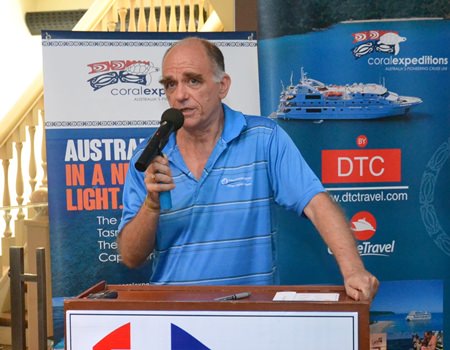 Tom Bishop, managing director of Bangkok’s DTC Travel, introduces Mark Fifield, general manager of Australia’s Coral Expeditions to talk to the PCEC about the World Heritage Site – The Great Barrier Reef.
Tom Bishop, managing director of Bangkok’s DTC Travel, introduces Mark Fifield, general manager of Australia’s Coral Expeditions to talk to the PCEC about the World Heritage Site – The Great Barrier Reef.
Further, Mark mentioned that reef industries, such as tourism and fishing, which contribute approximately $5.4 billion annually to the Australian economy and support about 69,000 jobs, are reliant on a healthy environment. The Great Barrier Reef Marine Park was created in 1975 by the Great Barrier Reef Marine Act. It was listed as a World Heritage site in 1981. There are many governmental agencies dedicated to Protecting the Reef, none more so than the Great Barrier Reef Marine Park Authority. A network of Conservation Zones in the Marine Park also protects and conserves the biodiversity of the ecosystem, providing a key strategy for improving the Great Barrier Reef’s health and resilience.
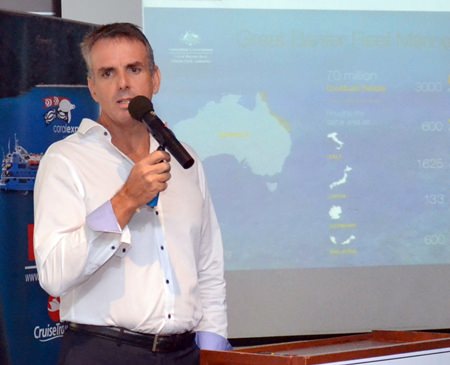 Mark Fifield, general manager of Coral Expeditions, describes the extent and nature of The Great Barrier Reef along with its marine life and the work of many organizations to protect it.
Mark Fifield, general manager of Coral Expeditions, describes the extent and nature of The Great Barrier Reef along with its marine life and the work of many organizations to protect it.
Mark described three kinds of reef: a fringing reef is directly attached to a shore, or borders it with an intervening shallow channel or lagoon; the term “patch reef” is commonly used to refer to comparatively small, isolated outcrops of coral surrounded by sand and/or seagrass; and a ribbon reef is a coral reef that is built on the edge of the continental shelf.
He said the modern Great Barrier Reef was laid down between 8,500 and 5,500 years ago. Carbon dating has indicated growth rates of up to 13 meters every thousand years. The overall growth rate depends to a large extent on location. Where 100 percent coral cover exists, the rate of calcium carbonate deposit is 10 kilograms per square meter every year which converts to a growth rate of 10 millimeters per year. Mixed areas of coral and algae grow at three millimeters per year, and sandy areas at .4 millimeters per year. Further, the Great Barrier Reef contains 3,000 coral reefs and 600 continental islands. It is home 1,625 types of fish, 133 varieties of sharks and rays, and 600 types of soft and hard corals.
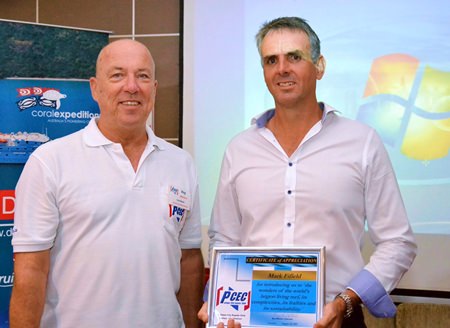 MC Roy Albiston presents Mark Fifield with the PCEC’s certificate of appreciation for his interesting and informative talk on Australia’s Great Barrier Reef.
MC Roy Albiston presents Mark Fifield with the PCEC’s certificate of appreciation for his interesting and informative talk on Australia’s Great Barrier Reef.
He said shark sightings are very popular with visitors. The value to Australia’s economy is $1,375 per sighting. The most common are the black tip reef shark, the white tip reef shark, the grey whaler, the bull shark and the tiger shark. Some 25 of the world’s 70 species of marine mammals commonly known as whales, dolphins, and porpoises occur along or close to the Great Barrier Reef. Population numbers are steadily increasing due to protection programs now in place. Humpback Whales have seen a ten percent population growth over the last few years. They are often close to shore and easy to find. He said that last week, one of the trips offered by Coral Expeditions saw 12 humpback whales in four days.
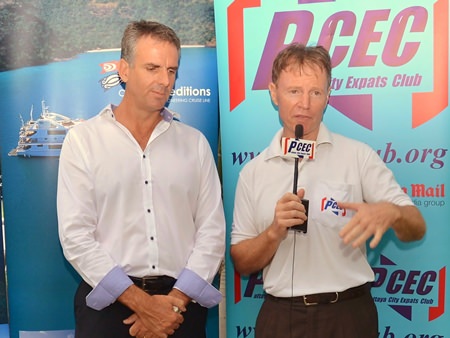 Member Ren Lexander interviews Mark Fifield about The Great Barrier Reef. To view the video, visit https://www.youtube.com/watch?v=BbCin3iSI6w.
Member Ren Lexander interviews Mark Fifield about The Great Barrier Reef. To view the video, visit https://www.youtube.com/watch?v=BbCin3iSI6w.
Mark mentioned that seven species of turtles are found worldwide, six of which can be found in Australian waters. All six species are considered endangered. He said there two genetically distinct populations of green turtle in the north and south. Volunteer organizations have been set up at several key areas within the Great Barrier Reef Marine Park and they are responsible for the rehabilitation of 100 to 120 turtles each year.
In answer to a question, Mark said there is no pollution on the Great Barrier Reef, and underwater visibility of 20 to 30 meters is common. He also talked about the variety of tours offered by his company Coral Expeditions. Great Barrier Reef cruises are for three, four or seven nights. On the 4-night itinerary guests have the morning to discover historic Cooktown, which is steeped in history with buildings dating back to the 1870s.
It was here that the famous explorer Captain James Cook took refuge during his voyage of discovery after claiming Australia as a British Colony in 1770. They also provide rainforest and tropical island tours. For more information, visit their website http://coralexpeditions.com.
After Mark’s presentation, MC Roy Albiston brought everyone up to date on upcoming events and called on Anne Smith to conduct the Open Forum, where questions are asked and answered about Expat living in Thailand, especially Pattaya.
For more information on the PCEC’s many activities, visit their website at www.pcecclub.org.
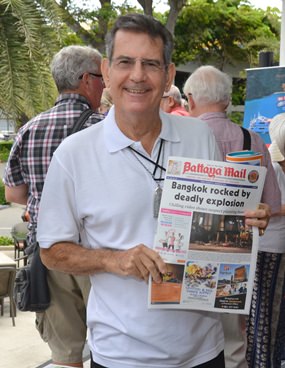 PCEC Member Jim Jones holds up his free copy of the Pattaya Mail which is made available to members and guests attending the PCEC’s Sunday meetings.
PCEC Member Jim Jones holds up his free copy of the Pattaya Mail which is made available to members and guests attending the PCEC’s Sunday meetings.
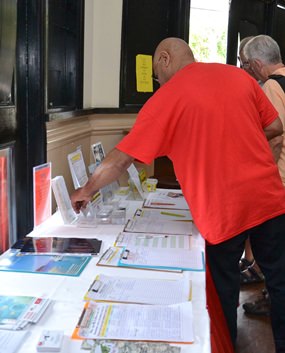 Members and guests interested in various activities being organized by PCEC members can use these sign up sheets to note their interest and to receive more information.
Members and guests interested in various activities being organized by PCEC members can use these sign up sheets to note their interest and to receive more information.




